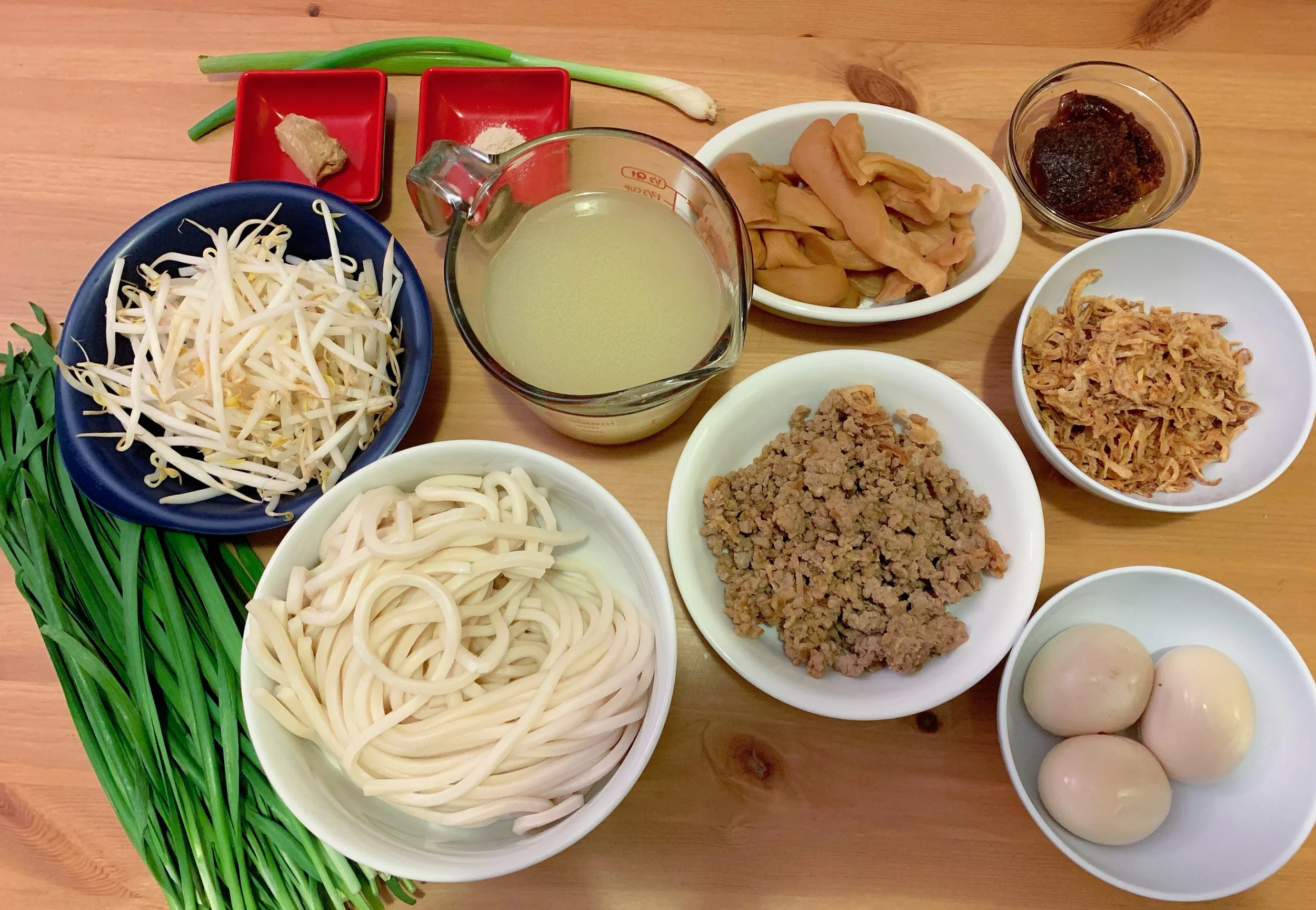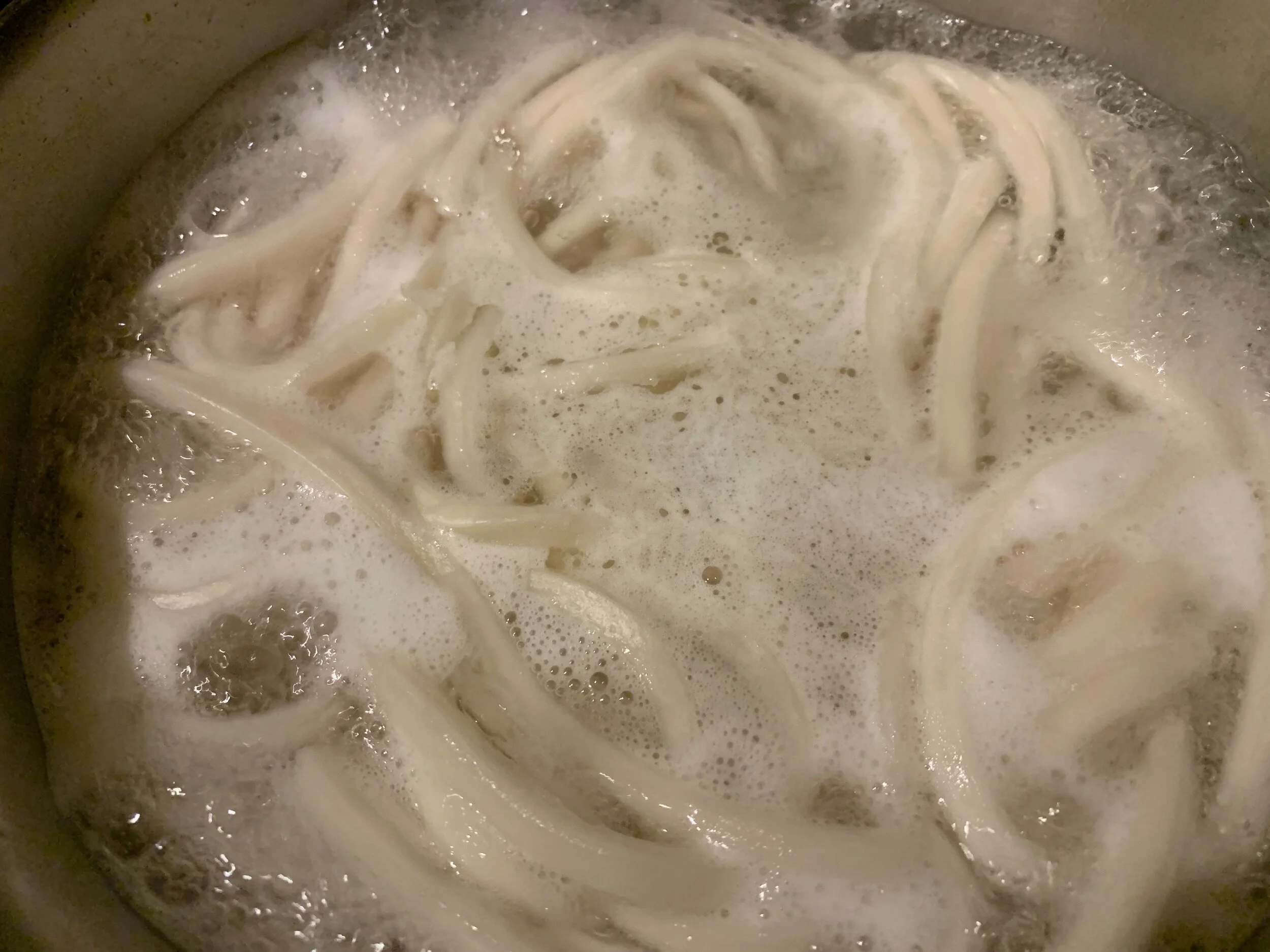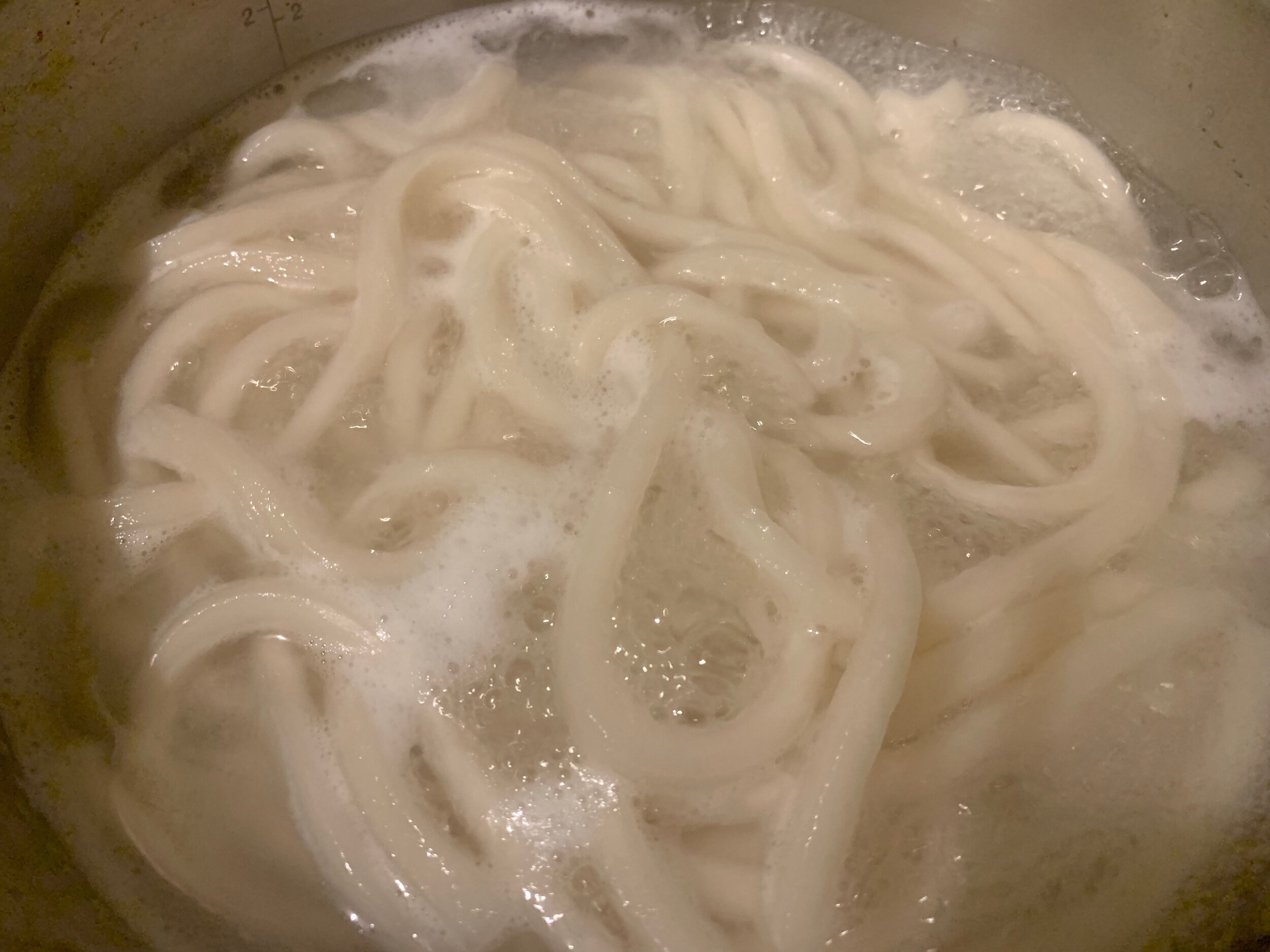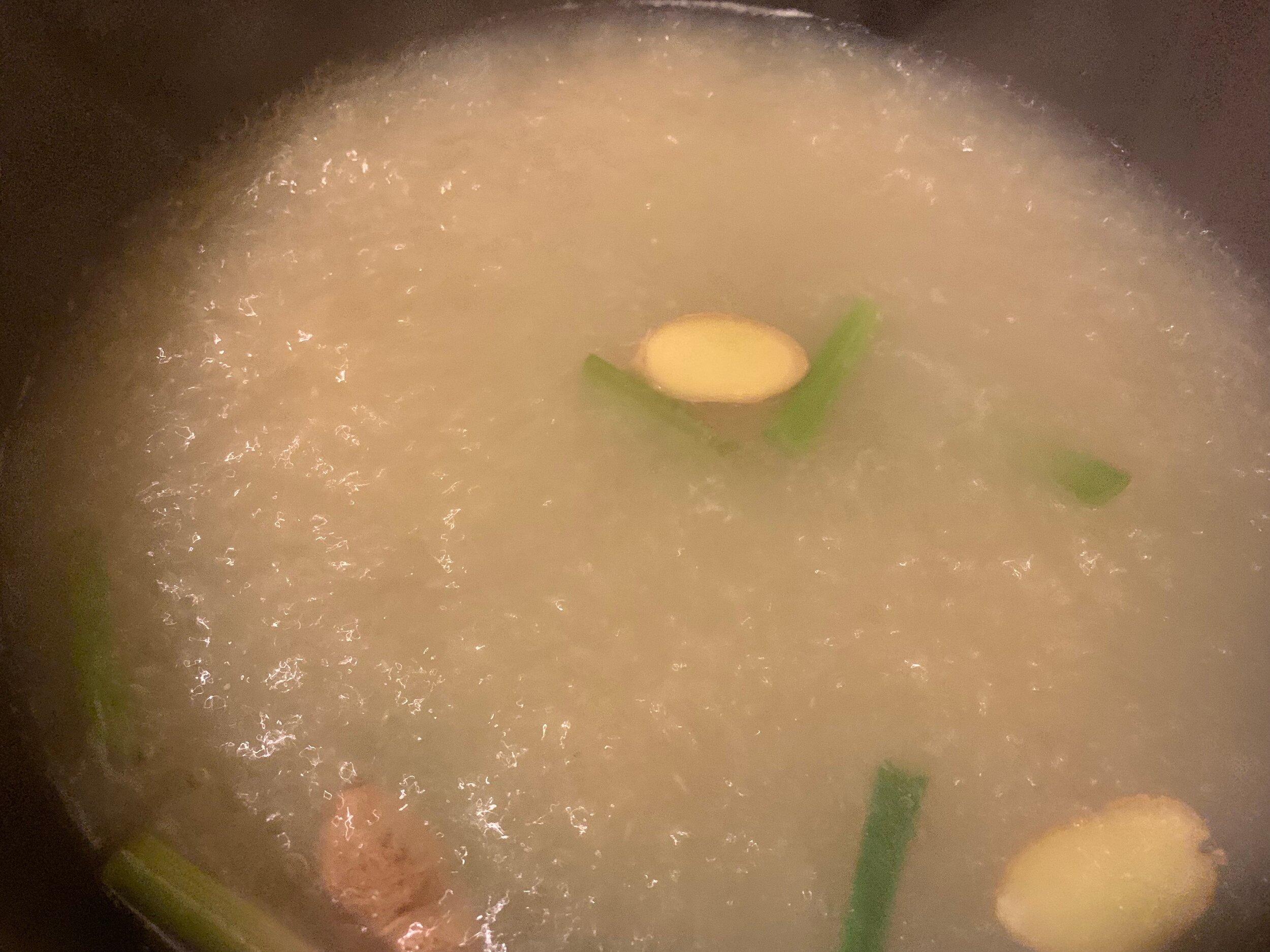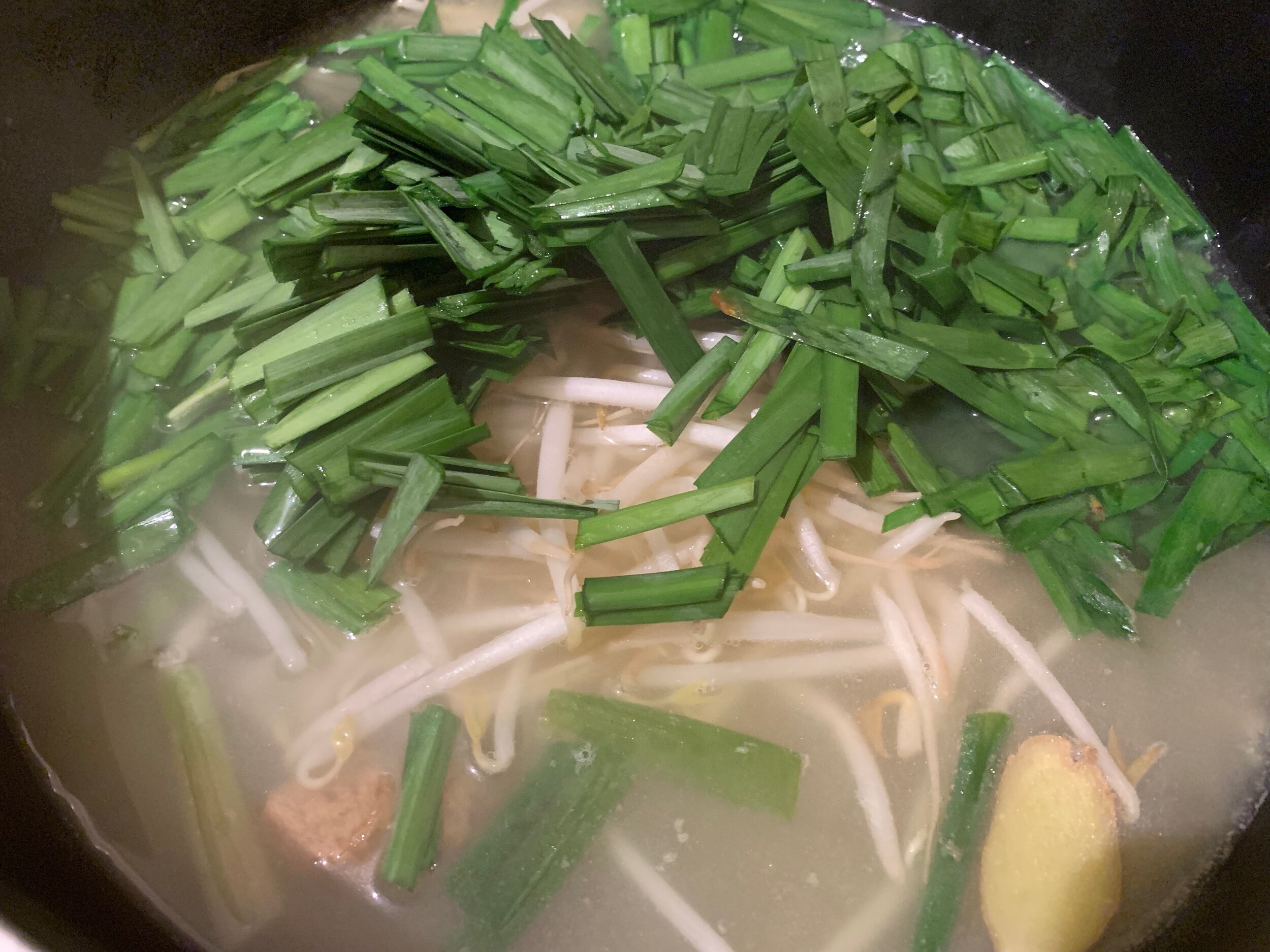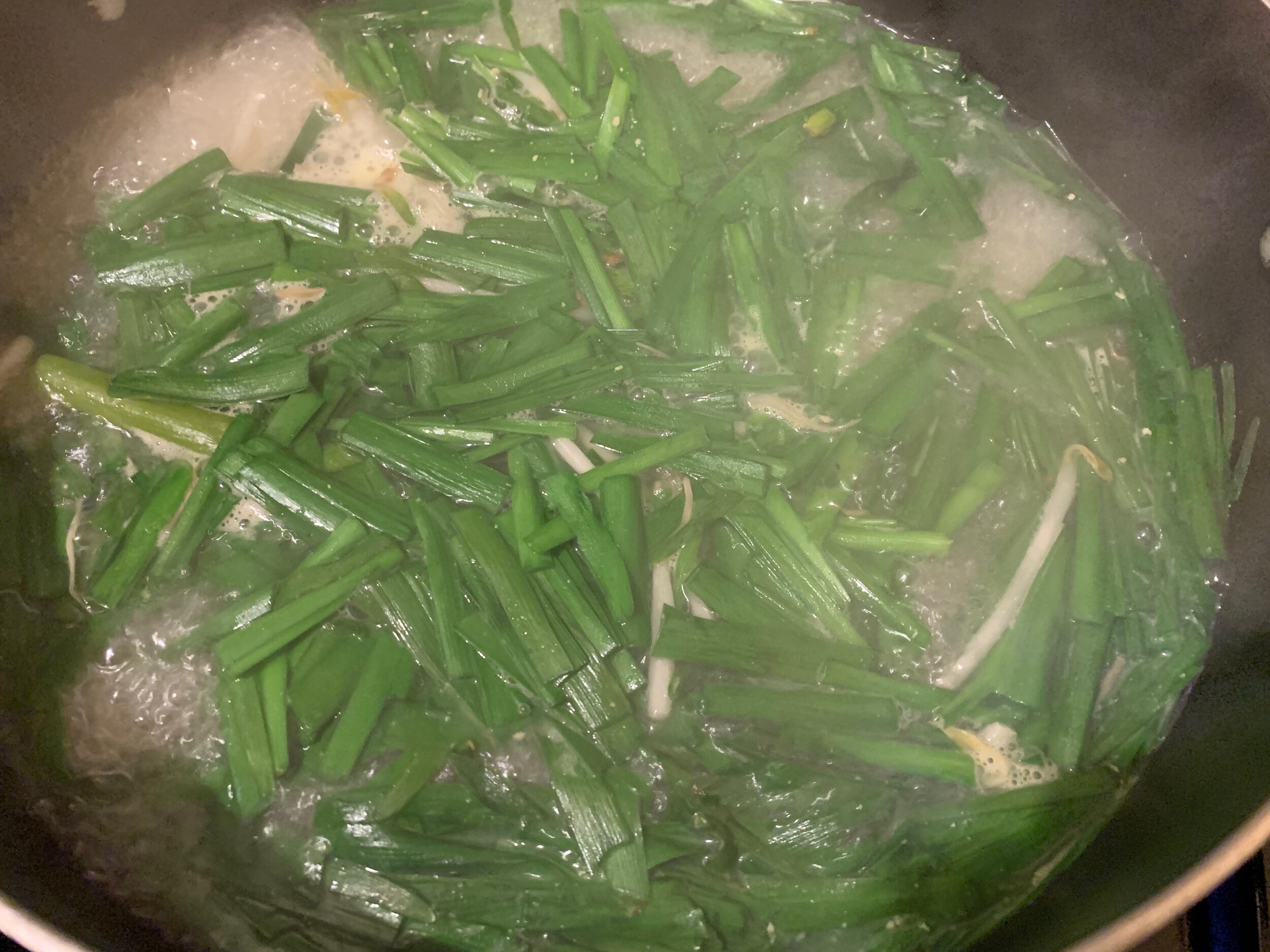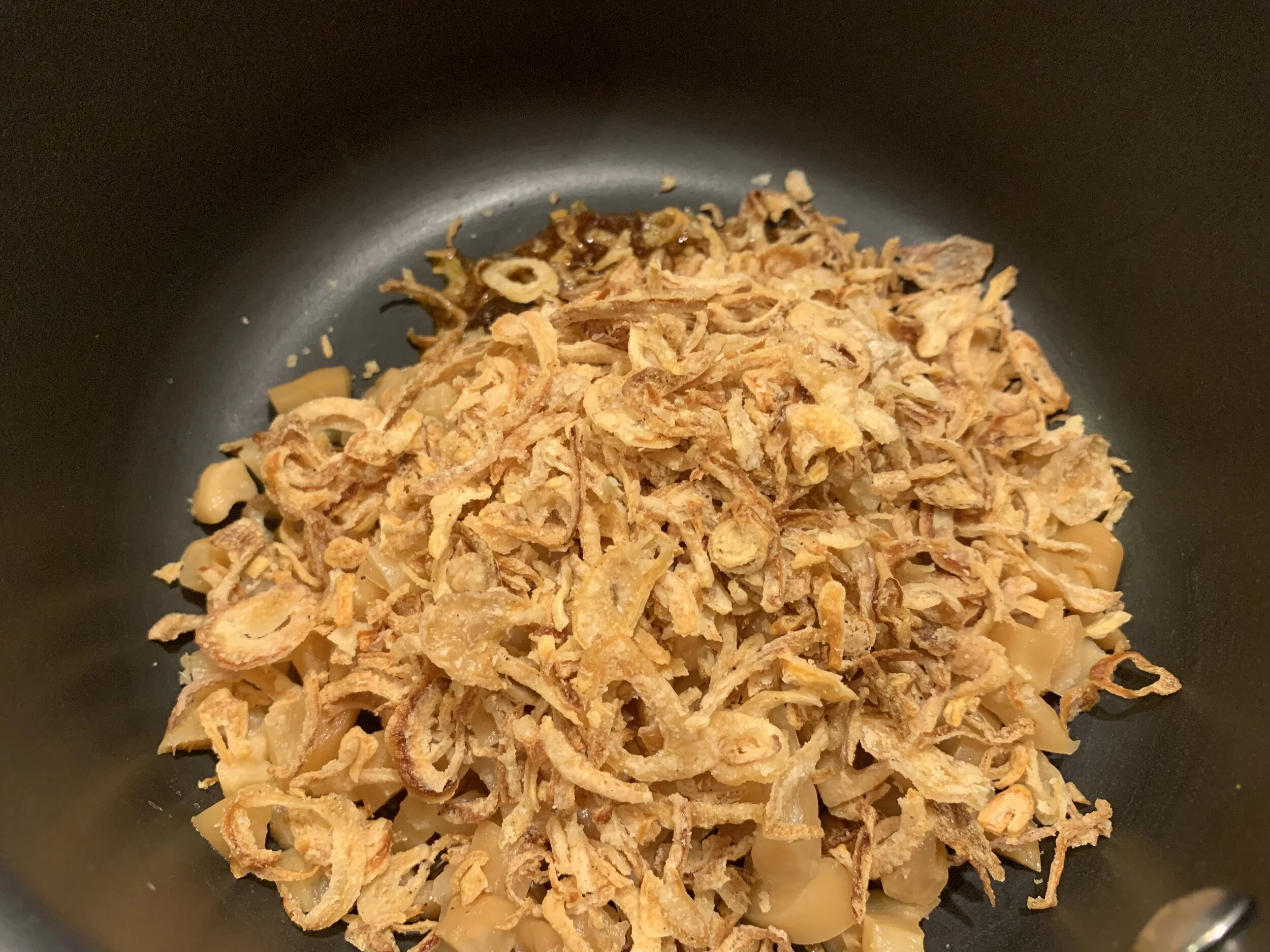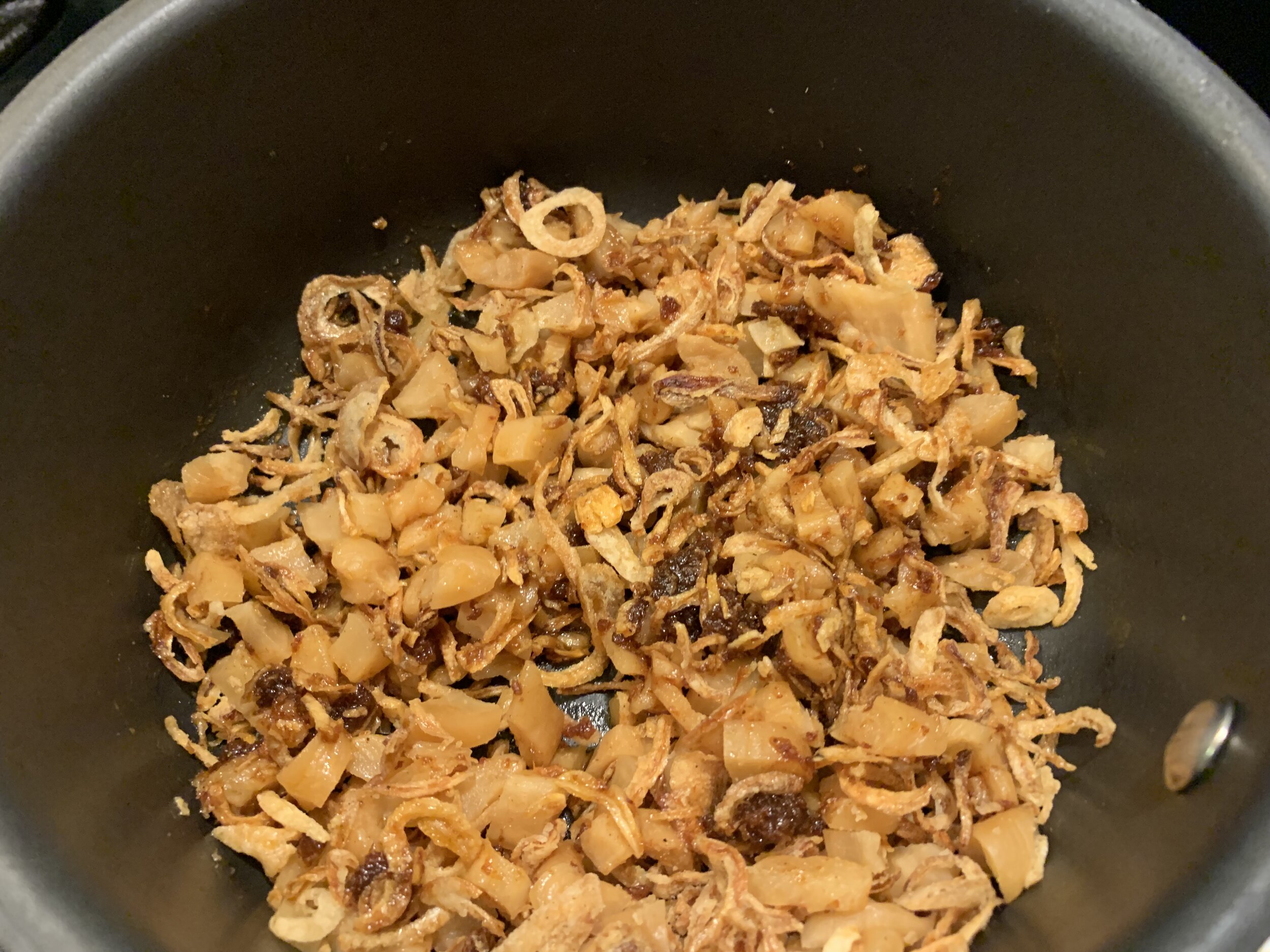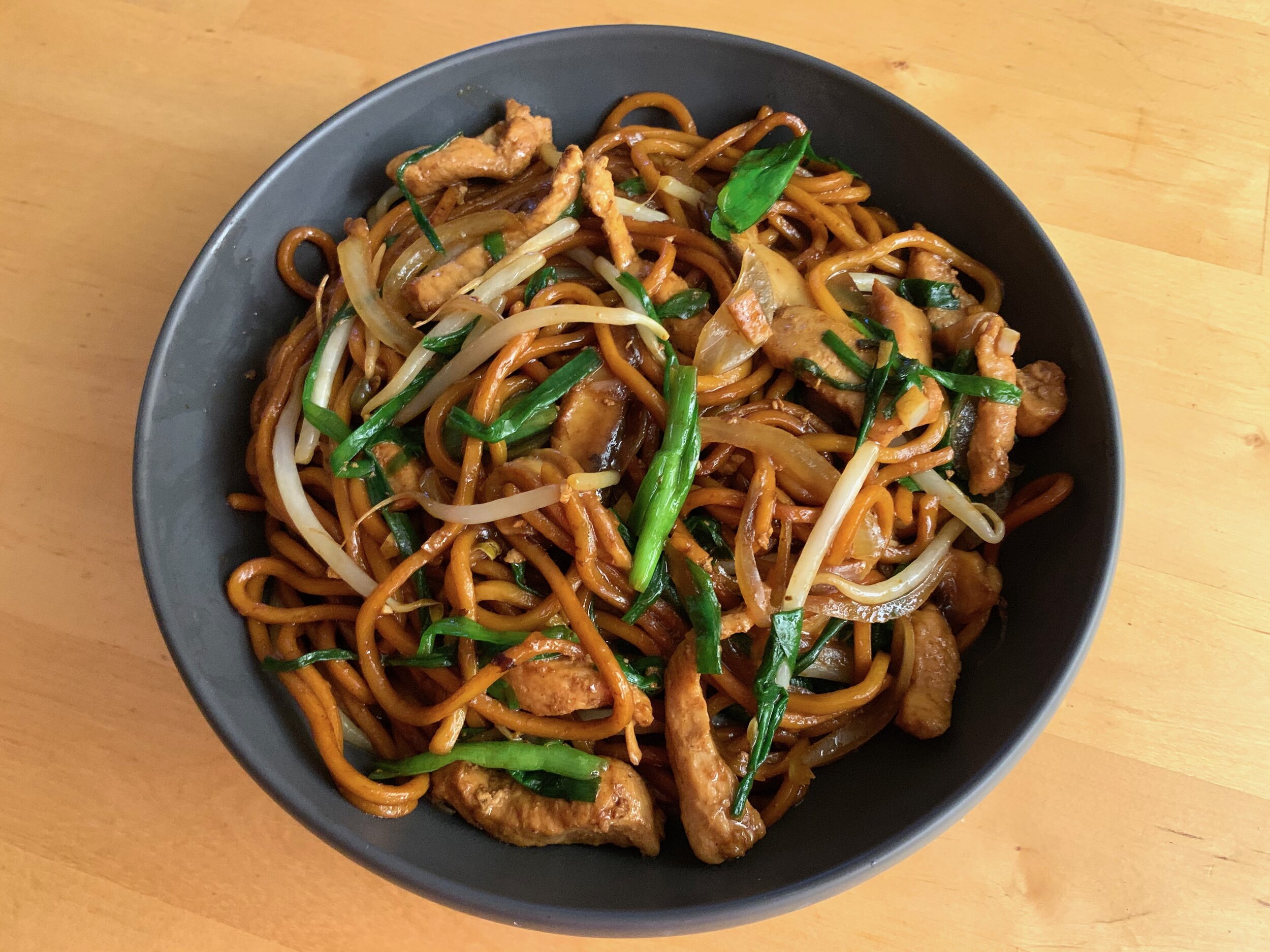Taichung Pork Noodle Soup
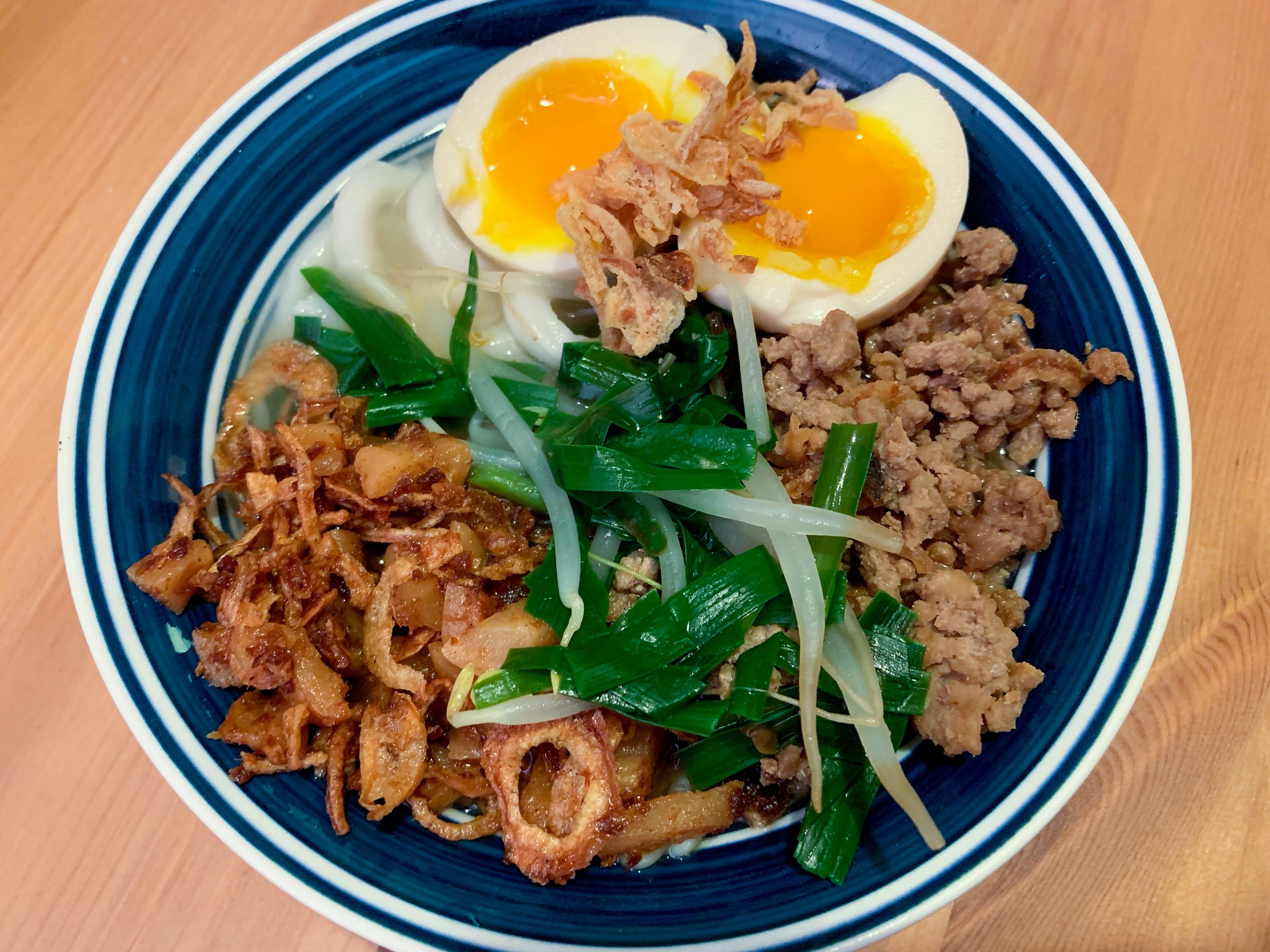
大麵羹 (Da Mian Geng)
While Taiwanese beef noodle soup is perhaps the island nation’s best known culinary export, it is not the only noodle soup native to Taiwan. In the city of Taichung, the go-to noodle soup found in street stalls is da mian geng, or daguyu, [1] wide noodles in a thick, flavorful broth, topped with minced pork and preserved radish.[2]
Da mian geng is traditionally made with a fresh, wide, alkaline noodle.[3] However, this noodle is practically impossible to find outside of the city of Taichung. We substitute Japanese udon noodles for this dish, which have a similar texture when cooked and are much more widely available. This quick and comforting recipe is perfect for a rainy day.
Ingredients
1 lb udon noodles
6 oz garlic chives
8 oz mung bean sprouts
For the Soup
2 cups chicken or pork stock
1 inch ginger, sliced
1 scallion
½ tsp white pepper
Toppings
8 oz Taiwanese minced pork, cooked
1 cup fried shallots
4 oz preserved radish
2 tbsp shacha sauce
4 soy sauce eggs (optional)
This dish employs two precooked components, half a batch of Taiwanese minced pork, and the optional but recommended soy sauce eggs. Both of these elements can be prepared a few days in advance, and the minced pork can be cooked and frozen.
There are three freshly prepared components of the soup: the noodles, the soup, and the preserved radish relish. Each of these components is simple to prepare on its own, but cooking them in parallel can become tricky. If you don’t feel comfortable doing this, feel free to cook them separately—they are all done quickly enough to still be warm!
Let’s begin with the noodles. Bring a pot of water to a boil, and add the udon noodles to the boiling water. Break the mass of noodles up with tongs or chopsticks, and boil the noodles per the package instructions until fully cooked. This will depend on the thickness of your particular brand of udon noodles, but is generally about 5 minutes for fresh noodles, or 10 minutes for frozen noodles.
While the noodles cook, we can begin our soup. In a second pot, bring 2 cups of chicken or pork stock to a boil. Prepare the aromatics by cutting the ginger into slices, and chopping the scallions into 1 inch pieces. Add the aromatics to the stock, together with ½ teaspoon white pepper. Simmer the soup for 5 minutes.
While the soup simmers, we can prepare some of our other ingredients. The preserved daikon radish is cured in salt, and should be soaked in water before using. Dice the radish into ¼ inch pieces, and place in a bowl with cold water. Soak them for 5-10 minutes. Wash the garlic chives thoroughly, and chop them into 1 inch pieces.
When the noodles are done, drain them and set aside, reserving the starchy noodle water. In street stalls, da mian geng is continuously simmered for hours. The starch thrown off from the noodles into the soup helps thicken the broth. While we want to keep our noodles tender and not overcook them, we can replicate this effect by adding to the soup pot 3 cups of the starchy water we cooked the noodles in. Return the soup to a boil, and add the bean sprouts and garlic chives. Cover and continue to simmer the soup until the chives are tender, which should take about 5 minutes.
While the vegetables cook, we will work on the relish. We will be using shacha sauce, a savory and slightly spicy Chinese condiment made from garlic, shallots, chili, and dried shrimp.[4] Shacha sauce has a fair amount of oil in it, so we can add it directly to a dry pan over medium heat. When the oil begins to bubble, drain the diced radish and add the pieces to the pan, together with ½ cup of fried shallots. Mix together and fry, stirring constantly for about 3 minutes, until warmed through and very fragrant. Remove the relish from the heat and set aside.
To assemble the noodle soup, place some of the cooked udon noodles in each serving bowl. Pick the ginger slices out of the soup and ladle it over the noodles, with plenty of vegetables. Top the noodles with a generous scoop of minced pork, a scoop of relish, and a soy sauce egg. Sprinkle over the remaining fried shallots and serve with extra preserved radish relish and minced pork at the table.
Substitutions
You can substitute most types of East Asian flour noodles for the udon noodles. While wide noodles are closer to the original, in a pinch I have even made this dish with instant ramen noodles. For more spice, increase the amount of white pepper, or add some chili sauce to the relish. Some other toppings you can try include shrimp and fish cakes. You can add other vegetables to the soup as well, such as thinly sliced bok choy.
[1] “大麵” translates directly to “big noodle,” though it is a homonym for “big face.”
[2] Preserved radish is also known as “蘿蔔乾”(luo bo gan), which means “dried radish.” In English, this ingredient is translated very inconsistently. I’ve pretty much seen every possible combination of the following words: preserved/salted/sun-dried/pickled radish/turnip/daikon. Unfortunately, there are so many different types of Asian pickles and preserved foods made with daikon or other radishes that if you are not a Chinese speaker, you may be best off going by a combination of look and the ingredients list. High quality preserved radish should be made of daikon radish, salt, and maybe a bit of sugar, with no other flavorings and minimal preservatives.
[3] Alkaline noodles exist in Chinese, Japanese, and Italian cuisines. Usually a combination of sodium carbonate (Na2CO3) and potassium carbonate (K₂CO₃) is added to the dough, giving the noodles a slight yellow color and a chewier texture. The most commonly consumed alkaline noodle is probably ramen. Many ravioli doughs are also alkaline.
[4] Shacha sauce is used in soups, stir-fries, and dipping sauces, especially for hot pot. It is a descendant of Southeast Asian satay sauce, as the name suggests, but has evolved into a very different sauce with few ingredients in common.
Recipe
Prep Time: 15 min Cook Time: 15 min Total Time: 30 min
Difficulty: 2/5
Heat Sources: 3 burners
Equipment: 2 pots, pan
Servings: 4
Ingredients
1 lb udon noodles
6 oz garlic chives
8 oz mung bean sprouts
For the Soup
2 cups chicken or pork stock
1 inch ginger, sliced
1 scallion
½ tsp white pepper
Toppings
8 oz Taiwanese minced pork, cooked
1 cup fried shallots
4 oz preserved radish
2 tbsp shacha sauce
4 soy sauce eggs (optional)
Instructions
1. Bring a pot of water to a boil, and cook the udon noodles to the package instructions, usually about 5 minutes for fresh noodles.
2. Meanwhile, place the stock in a second pot, together with the white pepper, sliced ginger, and scallion, chopped into one inch pieces. Bring to a boil and let simmer for 5 minutes.
3. While the stock simmers and the noodles cook, dice the preserved radish into ¼ inch pieces, and soak them in cold water. Wash and chop the garlic chives into 1 inch pieces.
4. Drain the cooked noodles, reserving the starchy noodle water. Add 3 cups of the noodle water to the pot with the stock, and return the soup pot to a boil.
5. Add the chives and bean sprouts into the soup, and continue to simmer until the chives are tender, about 5 minutes.
6. Add the shacha sauce to a clean pan over medium heat. Drain the diced preserved radish and add the radish pieces to the pan, together with ½ cup fried shallots. Fry this relish, stirring constantly, until warmed through and fragrant, about 3 minutes. Remove the relish from the heat and set aside.
7. Once the chives in the soup are done, remove the soup from the heat.
8. To assemble the noodle soup, place some of the cooked udon noodles at the bottom of each bowl. Ladle over the soup and vegetables, and top with the cooked minced pork, preserved radish relish, soy sauce eggs, and the remaining fried shallots.
